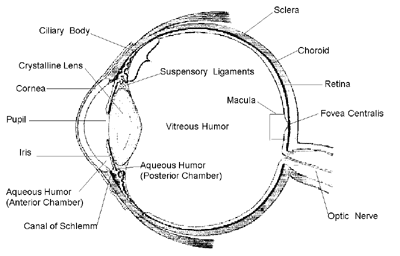< Page 2 of 9>
1 2 3 4 5 6 7 8 9
Anatomy
& Physiology
Major Ocular
Structures

The eye is very much like a camera. The camera produces an image by focusing light through a system of lenses to a sharp focus upon the film. In the eye, the retina is like the film of a camera and the cornea and crystalline lens are the lenses which focus the light. The refractive power of the average cornea is equal to about 43.00 diopters while that of the crystalline lens is 17.00 diopters. The combination of these two results in a total refractive power of a full 60.00 diopters. The transparent living structures through which light passes are the tear layer, cornea, aqueous humor, crystalline lens, and vitreous humor. The term "miracle of sight" takes on new meaning when one considers how living transparent tissue, devoid of blood vessels, can focus 60 diopters of power precisely on the retina. Combined with the variable power of the crystalline lens, and the ability of the retina to adjust its sensitivity to light under variable conditions makes this optical instrument, the human eye, the most sophisticated and exquisite of all.
The eye can be divided into three spaces or chambers: the space between the back of the cornea and the iris is called the anterior chamber; the space between the iris and the lens is called the posterior chamber; the largest space between the lens and the retina is called the vitreous chamber.
< Page 2 of 9>
1 2 3 4 5 6 7 8 9